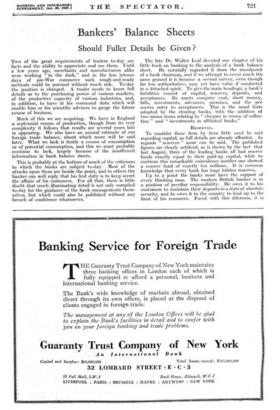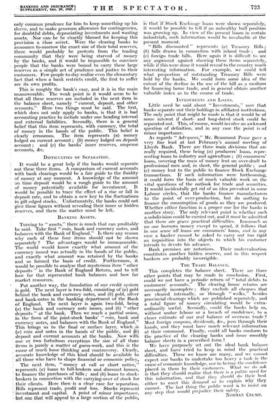Bankers' Balance Sheets
Should Fuller Details be Given ?
Two of the great requirements of traders to-day are facts and the ability to appreciate and use them. Until a- few years ago, merchants and manufacturers alike were working in the dark," and in the less intense days of pre-War commerce such rough-and-ready methods could be pursued without much risk. To-day the position is changed. A trader needs to know full details as to the purchasing power of various markets, of the productive capacity of various industries, and, in addition, to have at his command data which will . enable him or his scientific advisers to gauge the future course of business.
Much of this we are acquiring. We have in England a septennial census of production, though from its very complexity it follows that results are several years late in appearing. We also have an annual estimate of our foreign trade balance,- -about which-more will be said later. What we lack is firstly a census of consumption • or of potential consumption, and this we must probably continue to lack, largely ' because of the insufficient information in bank balance sheets.
This is probably at the-bottom of much of the criticisms to which the banks are subject to-day. Most of the attacks upon them are beside the point, and to others the banker can well reply that his first duty is to keep secret the affairs of his customers. For all that, there is little doubt that 'much illuminating detail is not only compiled to-day for the guidance of the bank managements them- selves, but which could also be published without any breach of confidence whatsoever. The late Dr. Walter Leaf devoted one chapter of his little book on banking to the analysis of a bank balance sheet. He naturally regarded it from the standpoint of a bank chairman, and if we attempt to. cover much the same ground it is because a second survey, even though far less authoritative, may yet have value if conducted in a detached spirit. To give the main headings, a bank's liabilities consist of capital, reserves, deposits, and acceptances. Its assets comprise cash, short money, bills, investments, advances, premises, and the per contra entry to acceptances. This is the usual form adopted by the clearing banks, with the addition of two minor items relating to " cheques in course of collec- tion " and " investments in affiliated banks."
RESERVES.
To consider these item by item little need be said regarding capital, as full details are already afforded. As regards reserves " more can be said. The published figures are clearly artificial, as is shown by the fact that last August, three of the leading banks all had reserve funds exactly equal to their paid-up capital, while to continue this remarkable coincidence another one showed a reserve fund of exactly ten millions. It is common knowledge that every bank has huge hidden reserves. Up to a point the banks must have the support of every thinking man. The modern British banker is in a position of peculiar responsibility. He owes it to his customers to maintain their deposits in a state of absolute security, and he Owes it to the country to lend up to the limit of his resources. Faced with this dilemma, it is only common prudence for him to keep something up his sleeve, and to make generous allowance for contingencies, for doubtful debts, depreciating investments and wasting assets. -Nor -can-he be exactly blamed for keeping this - . • - _ — • . • provision a close secret. Were the clearing banks to announce to-morrow the exact size of their total reserves, there would probably be protests from the trading community that they were being starved of money by the banks, and it would be impossible to convince people that the banks were bound to carry these large reserves as a simple act of prudence and justice to their customers. Few people to-day realize even the elementary fact that when a bank, restricts credit, the first to suffer are its own profits.
This is roughly the bank's case, and it is in the main unanswerable. The weak point in it would seem to be that all these reserves are included in the next item in the balance sheet, namely " current, deposit, and other accounts." Here two things must be said. The first, which does not only apply to banks, is that it is bad accounting practice to include under one heading internal and external liabilities. Secondly, there is a general belief that this item represents, with currency, the total of money in the hands of the public. This belief is clearly erroneous. The item represents (a) money lodged on current account ; (b) money lodged on deposit account ; and (c) the banks' inner reserves, suspense accounts, &c.
DIFFICULTIES OF SEPARATION.
It would be a great help if the banks would separate out these three items. A comparison of current accounts with bank clearings would be a fair guide to the fluidity of money at any moment. A knowledge of the amount on time deposit would be_ a rough guide to the amount of money potentially available for investment. It would be possible to trace the effect of a rise or fall in deposit rate, and to obtain a new key to the fluctuations in gilt-edged stocks. Unfortunately, the banks could not give-these figures without- revealing their inner or hidden reserves, and there the matter must be left.
BANKING ASSETS.
Turning to " assets," there is much that can profitably be said. Take first " eoin, bank and currency notes, and balances with the Bank of England." Is there any reason why each of these four items should -not be shown separately ? The advantages_ would be immeasurable. The world would know exactly what amount of the currency issued was actually in the hands of the public, and exactly what amount was retained by the banks and so formed the basis of credit. Furthermore, it would be possible to analyse that mysterious item " other deposits ' in the Bank of England Return, and to tell how far that represented bank balances and how far market resources.
Put another way, the foundation of our credit system is gold. The next layer is two-fold, consisting of (a) gold behind the bank and currency notes, and (b) gold, silver and bank-notes in the banking department of the Bank of England. The next layer is again two-fold, being (a) the bank and currency note issues, and (b) " other deposits " at the bank. Then we reach a partial union, in the form of the joint-stock banks' " coin, bank and currency notes, and balances with the Bank of England." This brings us to the final or surface layer,' which „is (a) coin and notes in the hands of the public, and (b) deposit and -current accounts at the banks. Now with one or two fortuitous exceptions the size of all these items is .ptirely _a matter of guess-work, and this is the cause of much loose thinking and controversy. Clearly, accurate knowledge of this kind should be available to all those who have to shape financial or economic policy, The next item, " money at call or short notice," represents (a) loans to bill-brokers and discount houses, to finance the purchases of bills ; and (b) loans to stock- : brokers in connection with the carrying-over of stock for their clients. Here then is a clear case for separation. Bills represent- trade, profit and loss.. Stocks -represent investment. and capital. A point of minor importance, - hut_one that will appeal to .a large section of the public, - is that Excliange loans were shOwn separately, it would be possible to tell if an unhealthy bull position was growing up. In view of the present boom. in certain industrials, such information, would be invaluable at the present moment. " Bills discounted " represents (a) Treasury Bills ; (b) bills drawn in connection -with inland trade ; and (c) foreign trade bills. Here again it is difficult to see any argument against showing these items separately, while if this were done it would reveal to the country much interesting information. For example, we could tell what proportion of outstanding Treasury Bills were held by the banks. We could form some idea of the extent of the decline in the use of the bill as a medium for financing home trade, and in general obtain another valuable index as to the course of trade.
INVESTMENTS AND LOANS.
Little need be said about " Investments," now that banks separate out their holdings in affiliated institutions. The only point that might be made is that it would be of some interest if short- and long-dated stock could be separated out. This, of course, would involve an awkward question of definition, and in any case the point is of minor importance.
As regards " Advances," Mr. Beaumont Pease gave a very fine lead at last February's annual meeting of Lloyds Bank. There are three main divisions that arc really required, these being (a) producers' loans, repre- senting loans to industry and agriculture ; (b) consumers' loans, covering the mass of money lent on over-draft to professional men and, in short, the general public ; and (c) money lent to the public to finance Stock Exchange transactions. If such information were forthcoming, it could form the basis of much valuable work on the vital questions of 'the outlook for trade and securities. It would incidentally get rid of an idea prevalent in some Labour . circles, that the banks finance manufacturers to the point of over-production, but do nothing to finance- the consumption of goods as they are produced. Whether either function is a proper one for the banks is another story. The only relevant point is whether such a subdivision could be carried out, and it must be admitted that there are grave practical difficulties. Inasinueh as no one borrows money except to spend, it follows that in one sense all loans are consumers' loans, and in any case a banker cannot be asked to carry out too rigid an inquisition into the objects to which his customer intends to devote his advance.
Bank premises are notorious. Their undervaluation constitutes another hidden reserve, and in this respect bankers are probably incorrigible.
THE TRADE BALANCE.
This completes the balance sheet. There are three other points that may be made in conclusion. First, could we not have a periodic return of " total debits to customers' accounts." The clearing house returns are necessarily incomplete ; they exclude all cheques that arc cleared internally, or through " walks, besides provincial clearings which are published separately, and a total figure of money circulating would be extra- ordinarily useful. Secondly, could the banks help us, without undue labour or a breach of confidence, to a closer estimate of our real balance of overseas trade ? Most foreign coupons, dividends, &c., pass through their hands, and they must have much relevant information at their command. Finally, could all banks conform to the practice of the clearing banks and- issue 'monthly balance sheets in a prescribed form ?
We have purposely set out the ideal bank balance sheet, and have tried to keep in mind the practical :difficulties. These we know are many, and we cannot expect our banks to undertake too heavy a task in the cause of economic knowledge, nor to betray the confidence placed in them by their customers. What we do ask is that they should realize that there is a public need for this information, and that they should do their best either to meet this demand or to explain why they cannot. The last thing the public want ti to insist on any step that would prejudice their safety.
"NORMAN CRUMP. "NORMAN CRUMP.



























































 Previous page
Previous page